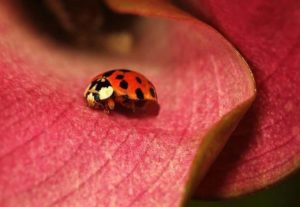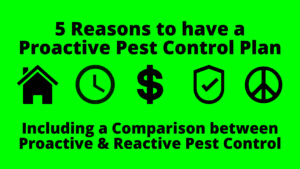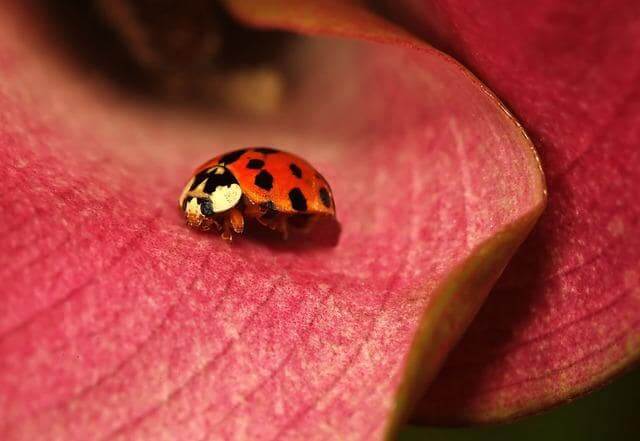Most folks know what lady bugs or Asian lady beetles look like, but they don’t always know how the heck they get inside their homes, waking up in the winter one sunny morning to find swarms on their windows.
Every year fall invading insects like Asian lady beetles, boxelder bugs, hornets, and wasps look for places to hibernate. Learn how we prevent these pests from using your home to hibernate with our simple Asian lady beetle control and lady bug control measures, the importance of preventative fall pest control, and more.
For the best preventative pest control service, call Done Right Pest Solutions: 651-342-9489.
Table of Contents:
- Asian lady beetles
- Nuisance pests — lady bug control
- How we treat – Asian lady beetle control
- Importance of preventative treatment
- Conclusion & next steps
Asian Lady Beetles

Nearly everyone knows what an Asian lady beetle or “lady bug” looks like. They range in color from orange to bright red. They have black spots on their domed bodies. Their heads are black, but their eyes are white. They have 6 legs, of course, and some might even call them “cute”, but they can be a nuisance too.
They used to be purely carnivorous, eating insects like aphids, but now they also eat honeydew, pollen, plant material, plant sap, nectar, and various fungi.
Lady bugs and Asian lady beetles were released into North America to help control aphids. Since then it has invaded North America and beyond. In 2015 the United Kingdom declared it the fastest invading species, only taking 10 years to infiltrate the entire country. This proves that lady bug control and Asian lady beetle control is extremely important.
Because lady bugs are red and Asian lady beetles are orange, that signifies as a warning sign to many predators. As a result they are not commonly eaten. This is called aposematism.
Lady bugs and Asian lady beetles also have another defense called “reflex bleeding”, where they bleed as a result of being held or threatened, literally pushing blood from their body to scare the predator. Commonly, they emit a yellow-ish color secretion that smells odorous to ward off predators.
Lady bugs and Asian lady beetles will often eat crops or farm plants, perhaps because that is where aphids are (another of their food sources) and only come into residential neighborhoods to over-winter.
Asian lady beetles and lady bugs give off pheromones to signal to other members of the same family that there is a sunny spot to congregate and that there are openings to get into afterwards to over-winter.
These bugs mate, lay eggs, and once the eggs hatch there are 5 larval stages prior to adulthood. Most females just lay clusters of eggs on the undersides of leaves, but some species lay extra infertile eggs for their larvae to eat as an extra food source when they hatch.
Most females just lay clusters of eggs, but some species lay extra infertile eggs for their larvae to eat as an extra food source when they hatch.
As you’ll learn in the next section, these flying pests commonly overwinter in homes, making their homes as bugs in the walls or insects in walls. Since they are small, not like mice that could be in your walls, you won’t even know that you have bugs in the walls…that is until they come out in late winter or early spring.
Nuisance Pests — Lady Bug Control
Over-wintering pests like Asian lady beetles, lady bugs, and Boxelder bugs aren’t just nuisance pests, they can actually stir up allergens in your home. These fall pests fall into this category, along with rodents, cockroaches, bed bugs, and dust mites.
Wondering how these pests stir up allergies? Any dead bugs in the wall voids or vents can cause respiratory or skin problems to humans and pets. As they decompose, their proteins get into the air. Depending on what people or animals have allergies to, sneezing, coughing, irritated mouth, throat, and eyes can ensue just from getting these little pests in your home.
Asian lady beetles and other fall pests have been known to stir up allergens in homes from within the wall voids. Once these bugs get into wall voids, their allergens can travel throughout the home through the ventilation system. Still, there are folks who are actually allergic to lady bugs.
It has been said that Asian lady beetles and lady bugs are attracted to contrasting colors. This means that if you have a light colored house, but have accent doors or shutters they will be attracted to the house. Likewise, if you have a dark colored house, but have lighter shutters or doors, these pests will be attracted to those light surfaces and try to enter into the home there.
There is nothing dangerous to lady bugs or Asian lady beetles. Many wonder, do ladybugs bite, and the answer is they can, but they don’t often bite.
In 2015 the United Kingdom declared it the fastest invading species, only taking 10 years to infiltrate the entire country.
It is important to treat these flying pests that can become bugs in the walls in no time. The most effective method is our preventative method, which you’ll read about in the next section.
How We Treat – Asian Lady Beetle Control
Done Right Pest Solutions is up-to-date on preventative pest control measures to ensure that these fall invaders don’t sneak in your home.
Our technicians begin your fall exterior service or Asian lady beetle control service by removing any cob webs, wasp nests, and other past pest activity from the exterior of your home with their web pole that can reach high peaks of 2 story houses!
Next, the exterior spray is applied with the power sprayers from the backs of their trucks. Their hose reaches 300 feet, to ensure full treatment of larger apartment buildings as well as larger houses.
The power sprayer can reach 3 stories tall, and our pricing is based on square footage because each house is different and each pest situation is different.
Finally, a 2 month warranty is given for this service. Keep in mind that the spray applied is a direct kill agent for any crawling, flying, or stinging insects that are on your siding at that time. But, the product dries clear within 1 hour of treatment, and then the residual component kicks in.
Boxelder bugs, Asian lady beetles, and lady bugs won’t die after immediately touching it, but they will die after 8 to 12 hours of touching your siding. So, if it is a sunny day and you see a lot of these fall invading pests sunning themselves on your home, check the foundation the next couple of days. You should begin to see a lot of dead ones. That is how you know it’s working!
Over-wintering pests like Asian lady beetles, lady bugs, and Boxelder bugs aren’t just nuisance pests, they can actually stir up allergens in your home. These fall pests fall into this category, along with rodents, cockroaches, bed bugs, and dust mites.
The importance of treating these flying pests is so they don’t overwinter in your home and become insects in walls. You can learn more about the importance of preventative treatment below.
For more information about seasonal pest control, check out our category within our blog.
Importance of Preventative Treatment
 Experts agree that proactive or preventative pest control is always more effective in the long-term than reactive pest control. You don’t have to eliminate something that never got inside in the first place.
Experts agree that proactive or preventative pest control is always more effective in the long-term than reactive pest control. You don’t have to eliminate something that never got inside in the first place.
In fact, we even wrote a comparison article about Reactive Pest Control and Proactive Pest Control. Learn the differences in that post.
Our fall exterior power sprays are an essential preventative treatment. Putting that preventative coating on the exterior of your home, your siding, foundation, soffit and fascia, prevents those over-wintering pests from getting inside and hibernating.
You may think that Asian lady beetles, lady bugs, and boxelder bugs aren’t harmful like stinging insects, so why not give them a place to hibernate? As you learned in the nuisance pests section, Asian lady beetles, lady bugs, and boxelder bugs are harmful in that they stir up allergens within your home that can cause respiratory issues for you.
Plus, our exterior fall power spray eliminates the chance of hornets, wasps, or yellow jackets getting inside and making nests in your wall voids, soffit, or fascia area.
If you don’t get preventative pest control in the fall, you risk these pests coming inside your home, waking up in the late winter, and coming into your home. They will often be attracted to windows and leave many home owners wondering where they could have possibly come from, as it’s below freezing outside.
Once they get inside your home, there isn’t much we can do. We can apply a crawling insect treatment inside, but it is more effective (though more work) for you to just keep vacuuming them up day after day.
If this exterior treatment sounds like a good idea to you, check out our Peak Seasons Plan. Our fall exterior power spray is 1 of 3 exterior sprays included in the package. Mice prevention is also included, so consider the Peak Seasons Plan to have an exterior exclusion service, and preventative rodent control devices installed.
Still have questions about the Peak Seasons Plan? That’s just fine! Give us a call to discuss your concerns and your specific situation, or check out our article How to Know if the Peak Seasons Plan is for You, where all of the frequently asked questions get answered in one place!
For more tips and tricks, check out our flying insects category within our blog.
Conclusion & Next Steps
In this post you have learned all about Asian lady beetles and lady bugs. You also learned that they can actually distribute allergens into the air within homes once they enter inside. For this reason, these pests are more than just a nuisance pest, they affect your health.
We explored how Done Right Pest Solutions staff performs Asian lady beetle control and lady bug control. You also learned that if any preventative fall pest control isn’t implemented, these pests get inside your home and that is why preventative pest control is so important. We even went over the answer to the question do ladybugs bite.
Because we feel it is so important to protect your health and home, we love the fall time of year. Fall is such a great time to start pest control for your home if you never have before. We hope you’ll give us a call if you ever have any questions: 651-342-9489.
We look forward to keeping you pest free this fall and winter,
Done Right Team
Have you ever seen Asian lady beetles or lady bugs sunning themselves on the exterior of your home? Did you wake up in the winter to them inside your home?
Want to learn more about savings and offers? Or maybe just about tips and tricks to keep your home pest free? Sign up for our custom newsletters!


Pingback: Simple & Effective Boxelder Bug Control | Done Right Pest Solutions
Pingback: Top 10 Reasons For Fall Preventative Mouse Control | Done Right Pest Solutions
Pingback: 6 Easy DIY Stink Bug Control Tips | Done Right Pest Solutions